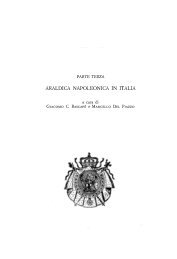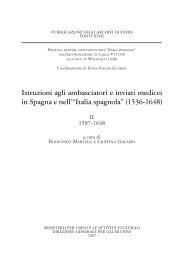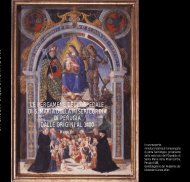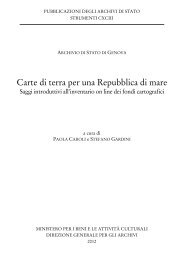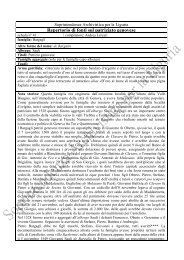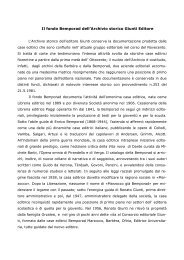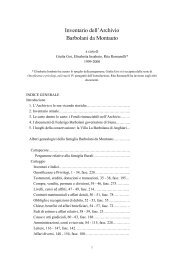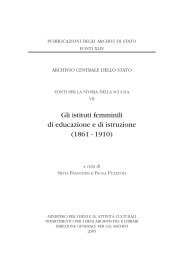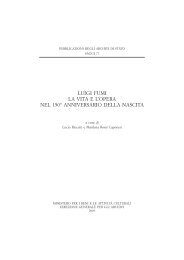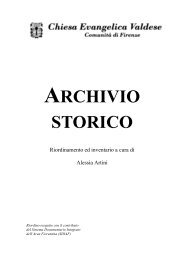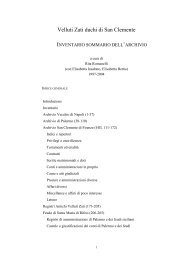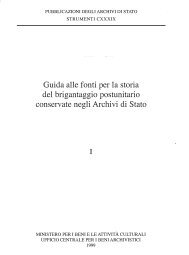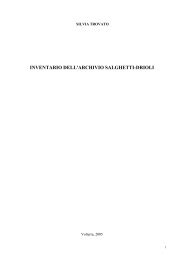ITALIA JUDAICA. Atti del I Convegno internazionale. Bari 18-22 ...
ITALIA JUDAICA. Atti del I Convegno internazionale. Bari 18-22 ...
ITALIA JUDAICA. Atti del I Convegno internazionale. Bari 18-22 ...
You also want an ePaper? Increase the reach of your titles
YUMPU automatically turns print PDFs into web optimized ePapers that Google loves.
ha-Kohen, who help develop a sophisticated method of critico-conceptual study;<br />
Alfasi, R. Ephraim, R. Joseph ibn Megas and Maimonides; however, in Italy no<br />
achievement of similar magnitude or cohesiveness or influence. The thirteenth<br />
century sees intense new creativity in Spain from R. Me'ir ha-Levi AbulaHa and<br />
R. Jonah Gerondi to Ramban, Rashba and R. Aharon ha-Levi, with a steady<br />
flow of hiddushim and criticaI review of the Mishnèh Toràh as a constant; rabbinic<br />
litrature in Provence, moving on a plateau whose elevation was fixed by<br />
the giants of the preceding century, is concerned with criticaI commentary on<br />
Alfasi and Maimonides, independent study and explication of the Talmùd in<br />
depth, composition of new up-to-date codes - see R. Manoal;, R. David ben<br />
Levi, R. Meshullam ben Moses, R. Judah Lattes, R. Me'ir ha-Koben, R. Aha<br />
ron ha-Kohen, R. David ben Samuel d'Estella, R. Yerul)am, R. Menal,em ha<br />
Me'iri; in northern EuropeJ there is the proliferation of Tosafot, codification<br />
and consolidation of earlier breakthroughs by an ever-increasing cadre of Talmudists,<br />
culminating in the school of R. Me'ir of Rothenburg and the several<br />
works of R. Asher b. Yehi' e1. Here Italy emerges on tbe scene, primarily in<br />
the personna of R. Isaiab ben Mali of Trani (Rid), a prolific autbor building,<br />
as we have noted, on North Africa-Spanish works, using Raslll as the literaty<br />
substratum of his own books, and relating freely and critically to the burgeo<br />
ning Tosafists.21<br />
2. Against this background and with this perspective, we may comment briefly<br />
on Rid, the pivotal, powerful personality in tbe curt, compressed chronicle of<br />
rabbinis literature in Italy. His output 'l,Tas volurn1noUS and variegated, including<br />
rosafOt, pesaqim, responsa ·and collections of essays or dissertations (e.g.,<br />
Sefer ha-Makhria') on selected topies of recognized difllculty or controversiality.<br />
As the volume of rabbinie literature grew through the ages, halakhists had to<br />
disentangle the ever-increasing multiplicity af possible meanings and suggested<br />
interpretations - this generalization fits tbe Sefer ha-Makhria' and so<br />
me af tbe long responsa. His writings are quoted by R. Isaac ben Moses<br />
of Vienna in his Or Zarua' and in tbe Shibbolei ha-Leqel; one of the last<br />
great Tosafists, R. Me'ir of Rothenburg (Maharam), mentions him in the same<br />
breath with Alfasi, Maimonides, and Rabbenu Gershom, four mighty, nearly<br />
invincible scholars with whorn no oue should ever disagree.<strong>22</strong> This is indeed<br />
high praise by association, even stripped of the eulogistic epithets. Examina-<br />
21 See M. HIGGER, Halako!. wa'-Aggadot, New York 1933, pp. 11-27. A. WERTHEIMER,<br />
see n. 1 above; A. ROSENFELD, Piskei ha-Rid, in Sinai, LIV (1963), pp. 290-301; S. ABRAM<br />
SON, Se/er ha-Lelf.et, in Sil1ai, LXV (1969), pp. 103-108; GUEDEMA},'N, Ha-Torah weha-<br />
1Jayyùn, III, p. 161, is more realistic than Cassuto in saying that the great ltalian Talmudists<br />
(i.e. Rid) appeared on the scene wo late " after the pioneering and formative achie<br />
vements of the Spanish and French Talmudists " and could not therefore create a tradition<br />
and school of their own.<br />
2 2 Teshuvot Maharam, Berlin, p. 286.<br />
392<br />
tion of bis impressive and comprehensive productivity dernonstrates its richness,<br />
representativeness and greatness. His praise is well deserved.<br />
Given a large measure of uniformity in medieval rabbinic literature, how<br />
does one evaluate the individuaI works of this genre and what significant<br />
features does one seek to identify in them? Inter alla, the following aspects<br />
come to the fore: (1) halakhic novelties in theory and practiee; (2) cultivation<br />
of special literary genres for halakhic writing; (3) methodologieal advances or<br />
refinernents or, at least, the generaI methodological orientation; (4) refIection<br />
of social and historieal realities or biographieal data; (5) integration of material<br />
from cognate areas of nonhalakhic learning (e.g. philosaphy, mystieism,<br />
philology, exegesis) and elaboration of meta-halakhic themes (particularly<br />
tatamei mizvo!), which reveai ideological commitrnent. In alI these respects,<br />
the works of Rid, many of which have just recently been published, are suggestive<br />
and significant and wartant intensive analysis.<br />
Bis works are also quite representative of contemporary rabbinic preoccupations<br />
and bis attitudes on many standard issues - such as use of the<br />
T osefla and Palestinian Talmùd, dialectieal attitude to Ge' onim or to predecessors<br />
in generaI - are typieal. He may thus profitably be referred ta when discussing<br />
major trends in medieval rabbinic literature or when trying to pinpoint<br />
the views and positions of such key contemporaries as R. Barukh (Sefer ha-Terumot),<br />
Nru,manides, R. Isaac Or Zarua' , or R. Me'ir of Rothenburg; let me<br />
mention, as a way of concretizing this generalization, that I found it useful to<br />
refer to him regularly in analyzing and characterizing the opinions and positions<br />
of his influential predecessor Rabad.<br />
However, even when tracing typological features, bIand reductionism must<br />
be avoided. Scholars cliffer from each atber intel!ectual!y as they do physical!y<br />
and emotionally. Streaks of individuality, speciaI nuances or emphases, terminological<br />
peculiarities, polemical thrusts, interpretative strategies, exegetical<br />
noverties and literary fIourishes, personal attitudes and aspirations, selfrevelatory<br />
glimpses - al! must be noted and appraised. The complexity of<br />
any creative individuaI, immersed in and bound by tradition, changes the tidy<br />
simplicity of ideaI types. Rid's resounding declaration in behalf of intellectual<br />
freedom and progress in the halakhic process clearly illustrates this point.<br />
The passage from his Teshuvot which makes the case for intellectual freedom<br />
and independent judgment as prelude to his analysis of a disputed halakhie<br />
issue is frequently noted - deserved1y so - by modern scholars and often<br />
repeated by pre-modern autbors, but I think has not yet been completely analyzed.23<br />
Let me attempt such an analysis briefly by suggesting that there is a<br />
three-tiered structure to his argument.<br />
23 Teshuvot, n. 62; see also n. 1 (see appendL"\:, belo\v). My students and friends,<br />
Bezalel Safran and Bernard Septimus, read this artide after I had mailed it to the confe<br />
rence organizers. I aro grateful for tbeir observatlons. Both commented on a point which<br />
clearly needed to be elaborated namely the possible relation or correlaction between Rid's<br />
393



